Southern Morocco Travel Guide
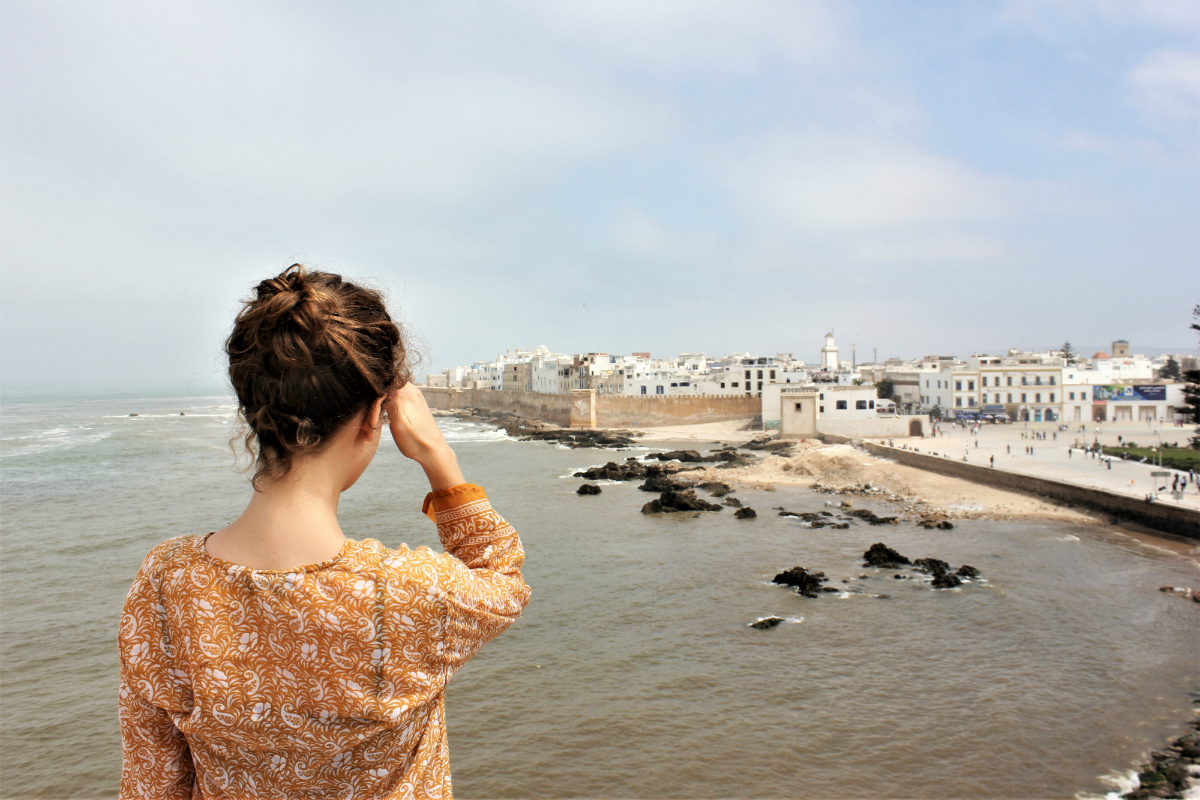
In this Southern Morocco travel guide, I share our travel route of south Morocco including the best riads in Marrakech, hiking the highest mountain in North Africa and taking a trip to the Sahara desert.
I’ve dreamed of staying in a Moroccan riad since I was a little girl. I used to watch TV shows where they would show you all of the most beautiful riads in Marrakech. They’d walk around the souks filming the pretty lanterns and drink mint tea from the silver teapots. I was infatuated with the idea of travelling to Morocco after that.
This year, my dream of travelling to Morocco came true. We took a trip to Southern Morocco and travelled around the south for 3 weeks. Morocco was a challenging country to travel. That wasn’t something the TV shows had prepared me for. We backpacked between different towns and villages, staying in riads and refuges, and we also travelled on Eid (not recommended). It was unlike anywhere else I’ve been before and a real culture shock.
Let’s get started with our Southern Morocco travel guide.
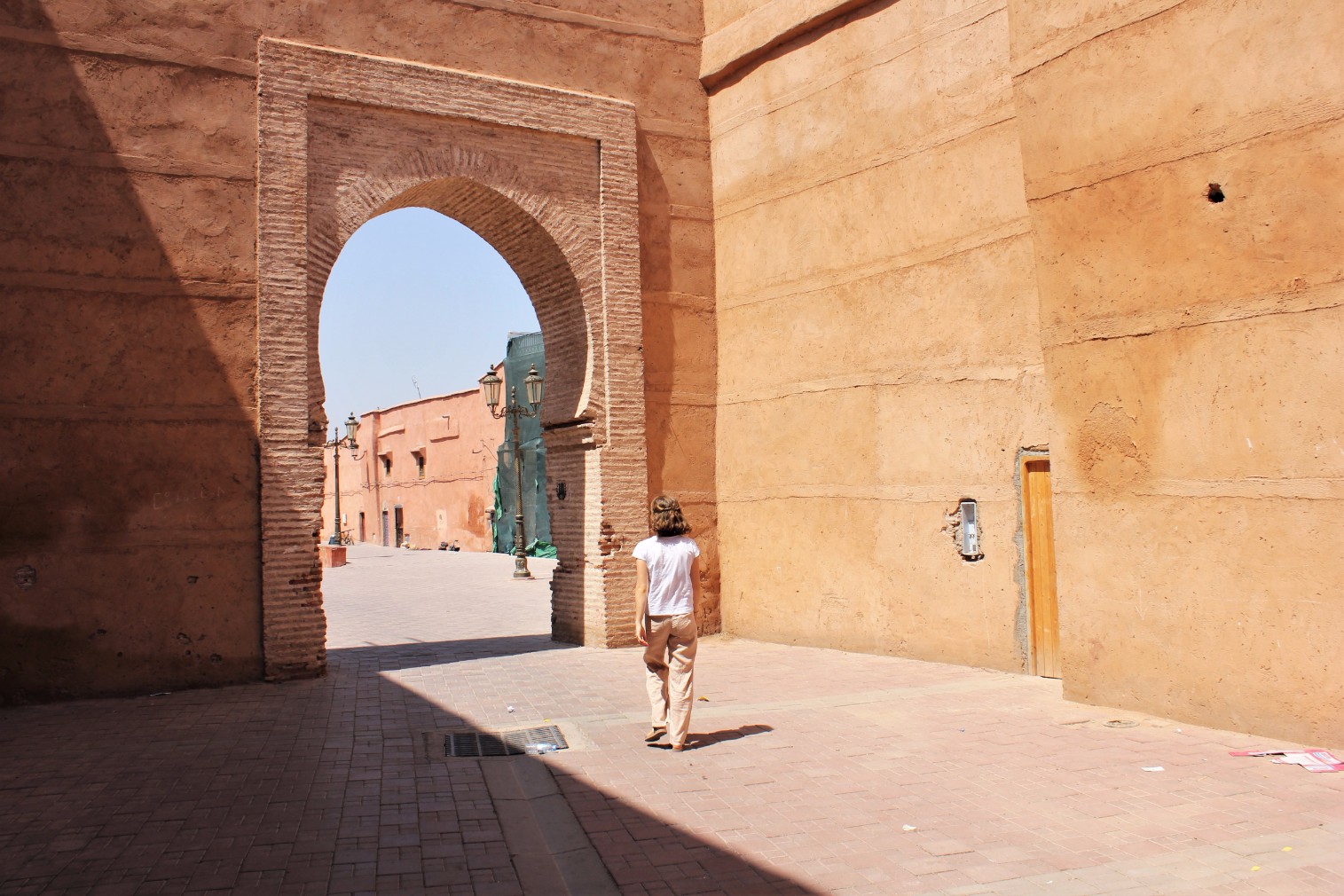
Southern Morocco Travel Route
We started our trip in Marrakech and travelled in a loop around the south of Morocco. We went from cityscapes and rocky mountains to desert dunes and sandy beaches all within 3 weeks of travelling Morocco. The travel loop could be taken either way round. If you plan to do a desert tour to the Sahara then it’s easier to arrange this leaving from Marrakech, though it can also be arranged from Ouarzazate.
Marrakech (2 days)
The best things about Marrakech are the riads and the roof terraces – the two things that take you away from the chaos of Marrakech’s streets. The is amazing but dodging the motorbikes and bicycles constantly flying around you at lightning speed through the narrow streets of the souks (markets) and the frequent hassling of locals trying to make 20 dirhams by giving you directions to places you don’t want to go is exhausting. In Marrakech, my advice is to use most of your travel budget to book a nice riad where you can escape the heat and the chaos of the streets when you need to.

Things to do in Marrakech: Jemaa el-Fnaa is the main square in Marrakech, pass through at night when it’s buzzing with street food stalls and local vendors, but don’t stay too long. The square is a tourist trap and not a place you’ll want to spend much time. Bahia Palace and El Badi Palace are the two palaces in Marrakech, both are beautiful. The Saadian tombs are nearby to here. We also really liked visiting the Ben Youssef Mosque with its ornate tiling. Don’t forget to check out the souks, the local markets spiralling through the covered streets in the medina where you can buy bags, shoes, clothing, lamps and other trinkets.
Best riads in Marrakech: We booked to stay at mid-range riad Riad Dar Sindibad in Marrakech. This riad is secondary to the main, very beautiful luxury Riad Spa Sindibad which we were lucky to be upgraded to free of charge when we arrived. Our stay at Riad Sindibad was amazing and we’d highly recommend it. The second time we stayed in Marrakech, we stayed at Riad Chez L’Africain. We couldn’t believe how beautiful it was and at such as reasonable price! Unlike most riads, Riad Chez L’Africain was very easy to find and well-located near to the Saadian tombs. Get £25 off your first Airbnb stay with this link.
Best restaurants in Marrakech: Marrakech’s best rooftop restaurant is Cafe Atay. Eat their vegetarian couscous on the terrace at sunset. Other good restaurants include Bakchich Cafe and Bazaar Cafe (serves alcohol).
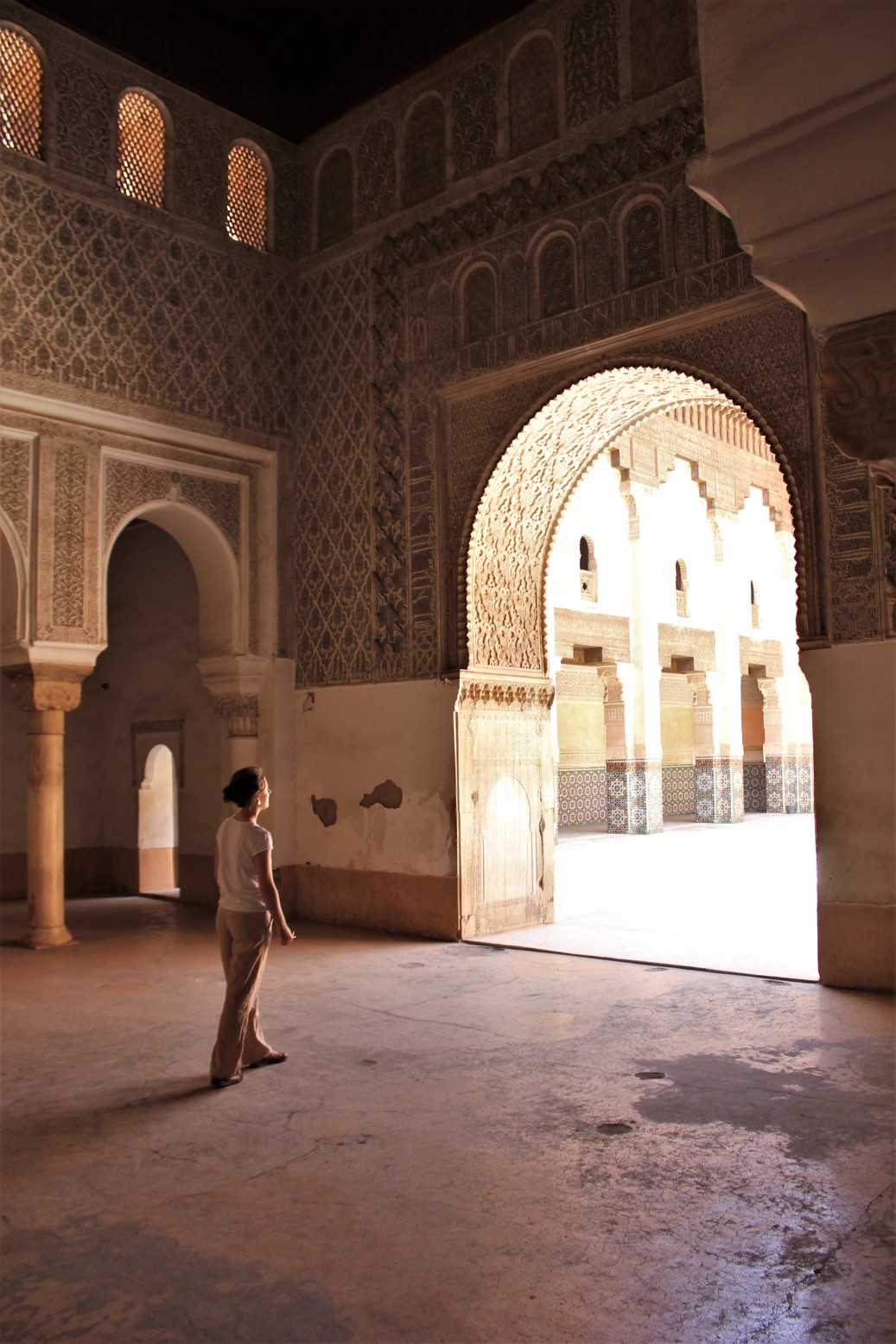
Imlil and Jebel Toubkal (2-3 days)
Imlil is a village in the High Atlas Mountains of Morocco. It’s 2 hours south of Marrakech and can be reached by bus and taxi, or directly by a grand taxi. Imlil is a common base for hiking in the Atlas Mountains and to surrounding Berber villages, though you could quite happily come for a weekend to enjoy the views. We stayed in Imlil before tackling Jebel Toubkal, the highest mountain in North Africa at 4,167m high. Toubkal is one of the most popular treks in the area, but the ascent is difficult and only for hikers with at least average to good fitness.
Best guesthouse in Imlil: Determined to get a room with a view, I dragged Luke up the gravel slopes of Imlil out of the village to find Gite Tizi Mizik. When we arrived, we met Hassan the owner and as we didn’t book ahead, we did some friendly bargaining to knock down the price of the room. The guesthouse has a beautiful separate private annex with a bedroom, bathroom, living room and small kitchen and balcony. The price was 200 dirhams (already a good price for such a nice room!), but we negotiated down to 150 dirhams as there weren’t other guests at the time. We had dinner at the guesthouse twice and both times were served amazing, fresh tagines. Skip the breakfast here though as it’s very basic, dry bread and jam. If you want to book in advance, you can get money off your Airbnb booking here.
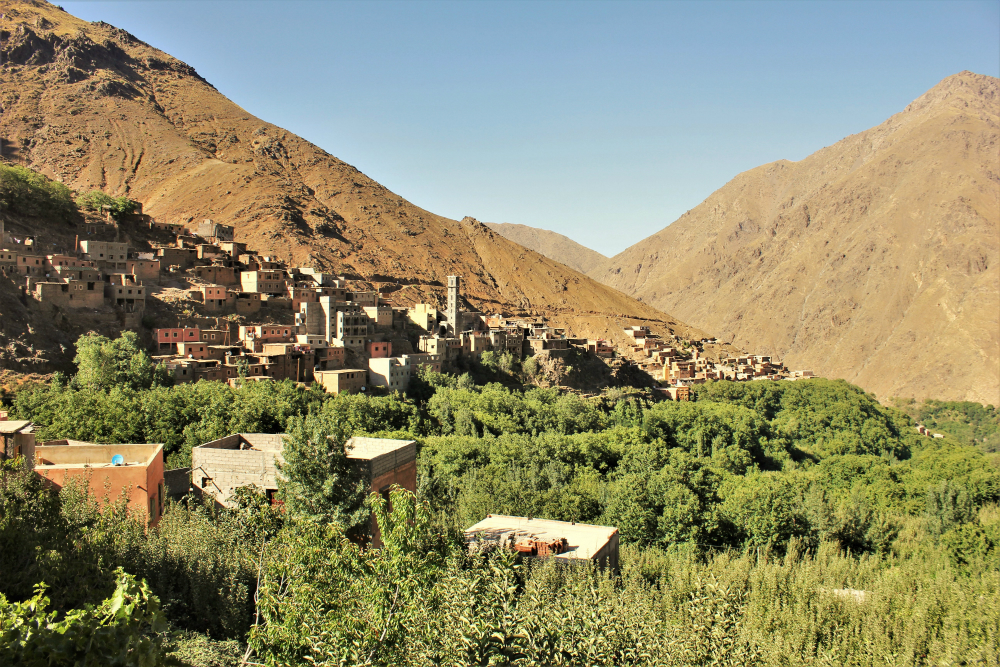
Aït Ben Haddou (1/2 day)
Aït Ben Haddou is the kasbah made famous as the filming location for Gladiator and part of Game of Thrones Season 3. It’s a UNESCO World Heritage site and a popular stopping point for tourists taking a trip to the Sahara desert (more about these tours in the Sahara desert section below). The village is a cluster of red earthen buildings which was originally built in the 17th century. It was inhabited by Berbers and Jews, but now only the Berbers remain living inside. This is because there’s no water or electricity inside Aït Ben Haddou. You can walk around Aït Ben Haddou in an hour.
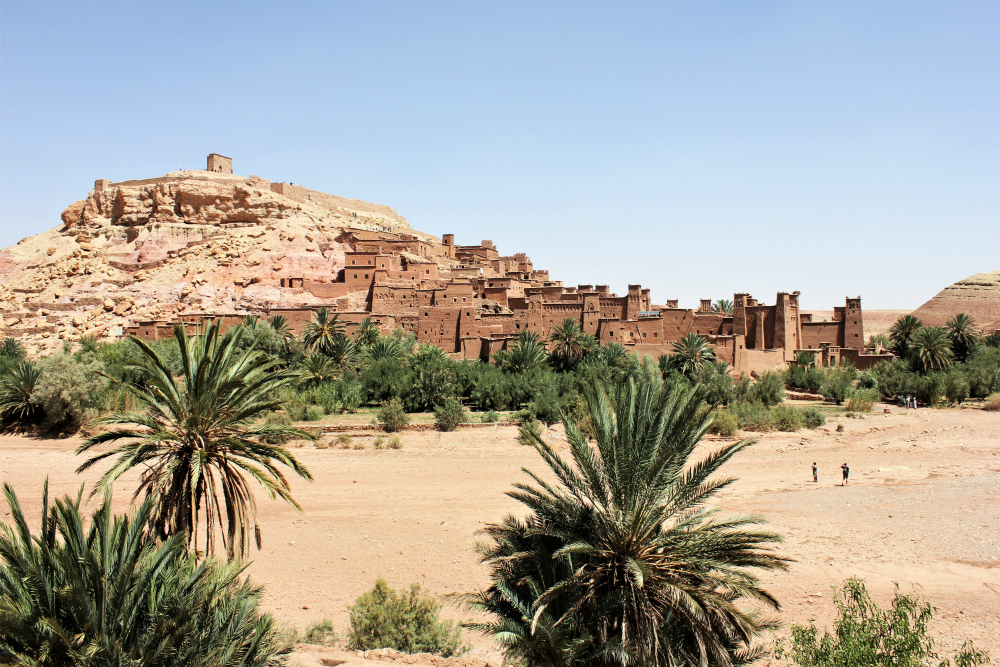
Sahara Desert (2-4 days)
The Sahara desert can’t be missed out of this Morocco travel guide because it’s a popular trip for many travellers. Though we usually prefer to travel independently, getting to the desert from Marrakech is a mission. The desert is a long way from any town that would be worth stopping in and not a comfortable journey to do by bus. There are three options for desert tours in Morocco:
- 2-day desert tour to Zagora
- 3-day desert tour to Merzouga
- 4-day desert tour to Erg Chigaga (further out from Zagora)
The tours leave either from Marrakech or Ouarzazate, though really there’s no reason to go from Ouarzazate unless you’re not going via Marrakech. The most popular desert tour is the 3-day one to Merzouga where the dunes are meant to be smoother and the sand finer. However, not wanting to spend so many hours driving nor in the desert, we opted for the 2-day tour to Zagora.
The tour makes a stop at Aït Ben Haddou on the first day, before driving through the Draa Valley to reach Zagora. You then take a camel ride to the desert camp. Note that the camels are not always well treated on the tours, but are nearly always included in the tour package. If you’re going further out into the desert, you could go by 4×4. These are arguably not better as 4x4s can disrupt native vegetation and wildlife in the area. On the Zagora trip, the camel ride only lasts for 1 hour so it is possible to walk if you prefer not to ride the camels (I walked on the way back after seeing poor treatment of the camels).
The most amazing part of the trip is the overnight stay at the desert camp. The camp is made up of large black tents with basic beds in a circle. They’re out in the desert dunes, though not very far from the nearest road into town. In the middle, there are rugs laid out where you drink tea, chat and listen to drumming from the Berbers. The red moon followed by the clear night sky and bright stars is an incredible sight.
On the way back, the tours make a brief stop at Ouarzazate before the long drive back to Marrakech. We jumped out here and left the tour to continue our loop of southern Morocco.
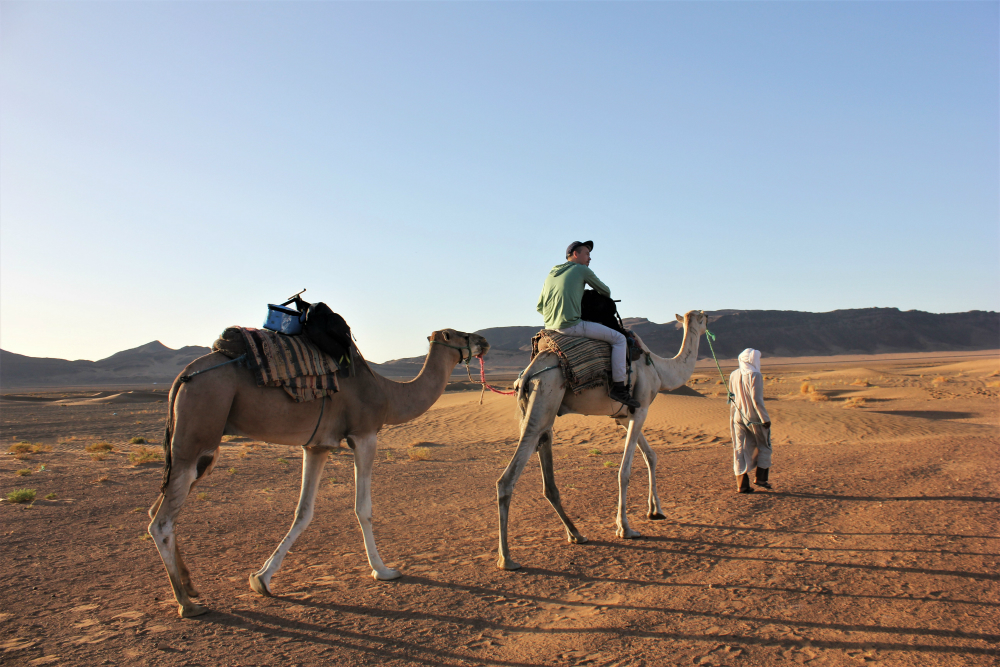
Are Sahara Tours Worth It?
Sahara desert trips are the Moroccan experience that most travellers have at the top of their Moroccan travel itinerary. For me, that actually wasn’t true (I was all about the riads). We ended up going at the last minute because we had a few days spare and because so many people had insisted that it was the best thing to do in Morocco. Though I enjoyed the trip a lot, I wouldn’t be pressured to include it on your Morocco travel route.
The tours are largely driving long distances to reach the desert and the conditions and treatment of the camels is generally not good. However, if you’re keen to see Aït Ben Haddou and go to the desert, then the tours allow you to do so much quicker and easier than organising it independently. From that perspective, they’re worthwhile.
Note that the costs of the tours vary between companies but in our experience, it didn’t matter. We were picked up from our hotel but 10 minutes later dumped on a roadside with a crowd of other tourists who had come from various minibuses. The drivers then proceeded to sort tourists depending on which tour they were on (herding goats) and mixed everyone up. The people on our minibus all booked through different companies. We were again separated out at the desert to different camps. The camps are all in a row (you can see the next one from yours) and all look the same from the outside.
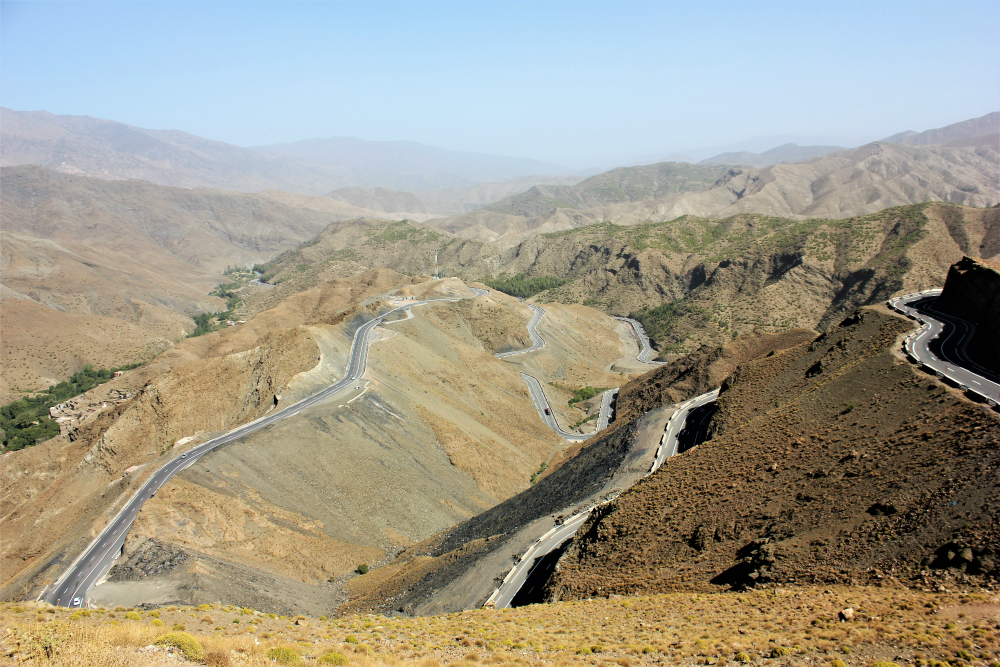
Ouarzazate (1 night)
Ouarzazate is nicknamed “the door of the desert” as it’s the stopping point for tours heading into the Sahara desert. We hadn’t planned to stop in Ouarzazate but ended up doing so because we were exhausted by the time we got here after hiking Toubkal and going to the desert in quick succession. It’s an interesting city but the only tourists here tend to be filmmakers filming at nearby production studios and at Ben Haddou. It means that you’ll see very few foreigners whilst here, and it also means that the restaurants are all local places and cheap.
Restaurants in Ouarzazate: Not going to lie, but there won’t be any restaurant you’ll be wild about eating at. My advice is to go to the main square (not usually my advice, but in this case it’s the only place to find restaurants) and pick wherever has locals eating there. We ate at a small restaurant called Galerie d’Art Café (the chef is also an artist) in the main square where other locals were eating after the 12-year old daughter who had excellent English talked us in. They, oddly, served pizza which was quite good by Moroccan standards and I ate a salty vegetable couscous. Habous next door has a good bakery where you can buy msemen (Moroccan square bread) and, surprisingly, croissants.
Taroudant (1-2 days)
Taroudant is the city where we felt we had the most ‘local’ and ‘authentic’ travel experience in Morocco. There are very few tourists here, but we chose to stop off in the city on the way through to Taghazout. We’re glad we did! The city is surrounded by city walls stretching for 6km and they are the most intact in Morocco. I recommend cycling around the walls in the early evening. In the right season, you can also use Taroudant as a base for hiking trips to the Berber villages in the Anti-Atlas mountains.
Best guesthouse in Taroudant: We stayed with a local guy called Abassi who we found on Airbnb. He has a traditional stone house with a garden. We were able to use his kitchen and cook tagine with vegetables we bought at the local market. Abassi is a tour guide during hiking season and was a super attentive host. He picked us up when we arrived, showed us the best restaurants in town and took us cycling around the city walls. An amazing Moroccan breakfast of omelette, freshly baked bread and honey is included. Real Moroccan hospitality! You can book Abassi’s place on Airbnb and get £25 off using this link.
Best restaurants in Taroudant: There’s really only one restaurant worth eating at in Taroudant and that’s Café Les Arcades. Our Airbnb host recommended it and warned us that many of the restaurants in Taroudant are not using fresh vegetables when cooking their meals, instead of reusing vegetables from the previous day or more due to lack of customers. Café Les Arcades does use fresh produce though. The cafe is located on the main square, shaded by trees. The other place we’d recommend is the coffee cafe Cafe Les Cafes. It’s a male-dominated cafe only serving coffee, but the coffee is really good and everyone was welcoming to me when I had coffee there.
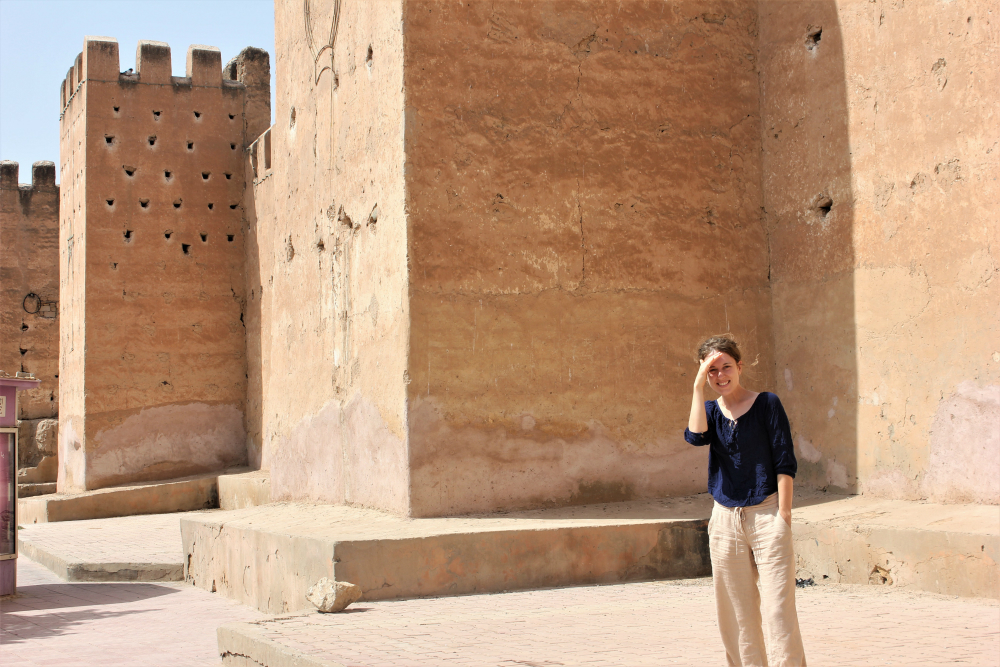
Taghazout (2+ days)
Next up on our Morocco travel guide, Taghazout. Twenty years ago it was a sleepy fishing village, but now this beach town is a surfer’s paradise. As well as surfers, digital nomads like us are attracted to Taghazout because of the incredible coworking space. The blue-and-white painted town has a similar look to Essaouira (see below) but is much smaller and jam-packed with surfers. It’s rough around the edges, but great fun. We stayed here 1 week, though how long you stays depends on if you surf and if you work.
Things to do in Taghazout: The thing to do here is surf. You can rent a board for €10 per day or have a surf lesson for €25 for a half-day. The waves are full of beginners and pros alike. Luke and I had an awesome time learning to surf and found the waves to be beginner friendly.
Best accommodation in Taghazout: The other thing to do in Taghazout is work. In town, there’s a coworking space called Sundesk set up by a German woman called Magda. Luke and I stayed here working online for a week and loved it. For €40 per night, you get a double bedroom, a delicious breakfast on the roof terrace, sea views and 24-hour access to the office. The wifi connection is the best in Morocco.
Best restaurants in Taghazout: We travelled out of season in Taghazout, and like in Taroudant, our host warned that the food in the restaurants was not always the freshest. However, we found some ‘safe’ places that we really liked. Check out Pizza Hot, a tiny local pizza place in the square, where you can get a pizza for 25 dirhams – many people ate here repeatedly to avoid the risk of getting sick. If you want a beach-front restaurant with a gorgeous view, go to Windy Bay. The best cafe in town is Red Clay.
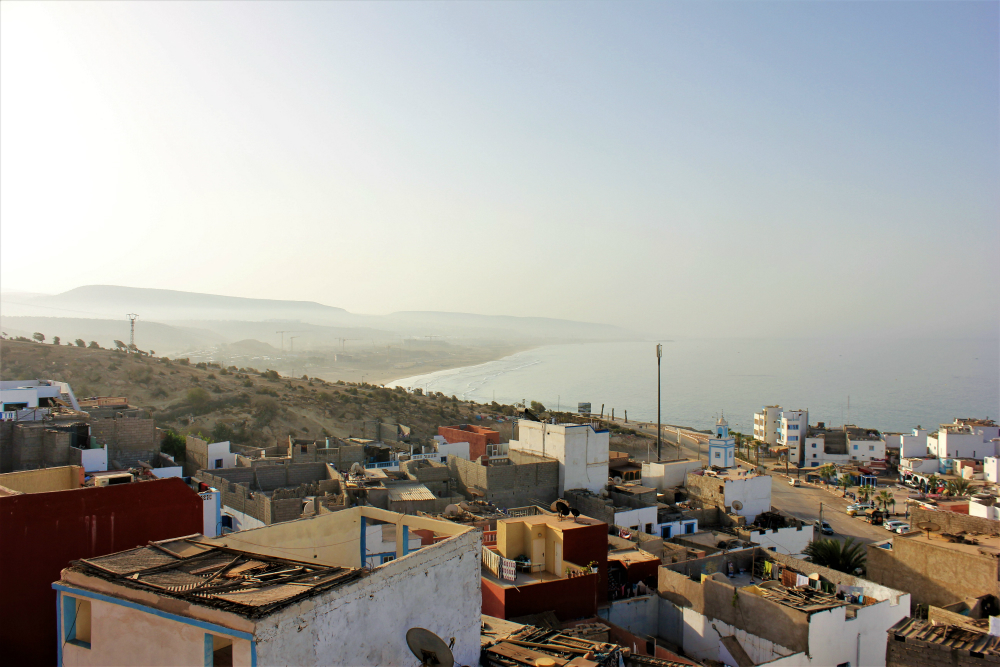
Essaouira (2 days)
Essaouira is a port city with a white-painted medina and a windy beach. Many people take day-trips from Marrakech, as it’s only 2.5 hours by bus, but it’s better to spend the weekend and relax. We met up with old friends and rented a whole riad for the weekend.
Things to do in Essaouira: The city only has limited things to do, but it’s a good place for some windy beach days and to wander around the medina shopping for local handicrafts. They have quirky jewellery for sale here. Walk up on the Skala du Port ramparts to get a nice view of the city if it’s not too misty. The coastal fortress here also featured in Game of Thrones. The Sidi Mohammed ben Abdallah Museum has an overview of the history of Essaouira and is set inside a pretty building.
Best riad in Essaouira: We were in a group of seven so rented the whole Riad Quelig to ourselves. The riad was gorgeous and cool inside. Get £25 off booking a riad on Airbnb.
Best restaurants in Essaouira: There’s a small square of vegetarian and vegan restaurants sitting side-by-side, including Le Corail at Latifa and Shyadma’s Veg Food. But the best food we ate in Essaouira was street snacks including msemen (Moroccan square flatbread) and khobz (Moroccan pita bread).
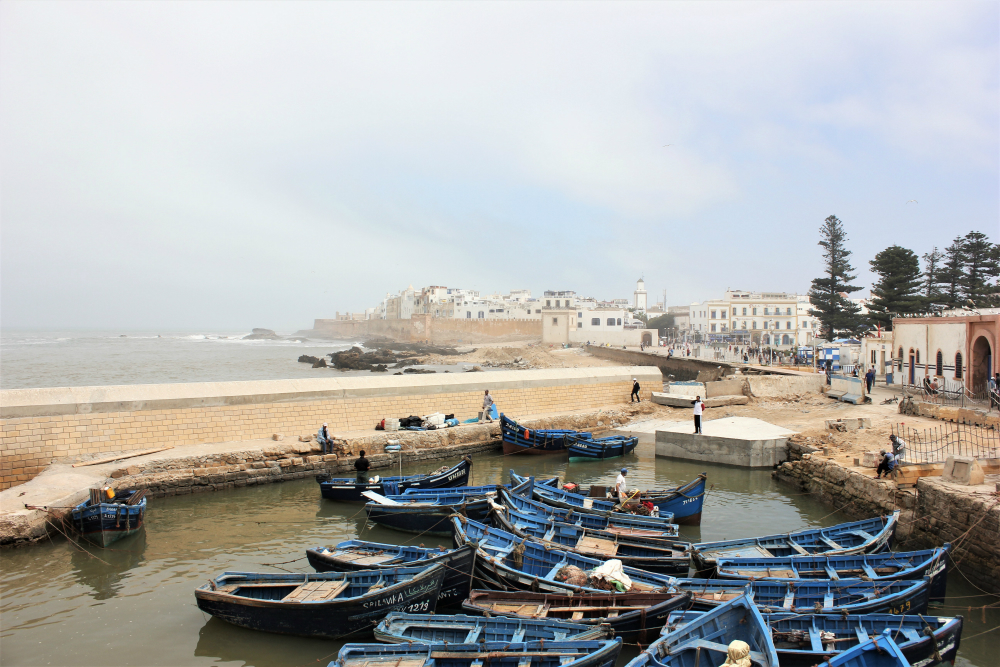
Morocco Travel Guide
That’s the end of our Morocco travel guide! From Essaouira or Taghazout, you can easily loop back to Marrakech to fly out of Morocco from here. However, there are other airports, including in Agadir, that also receive flights from Europe. If you’re thinking about taking a trip to the south of Morocco, we’d love to hear about your plans in the comments!
LIKE IT? PIN IT!
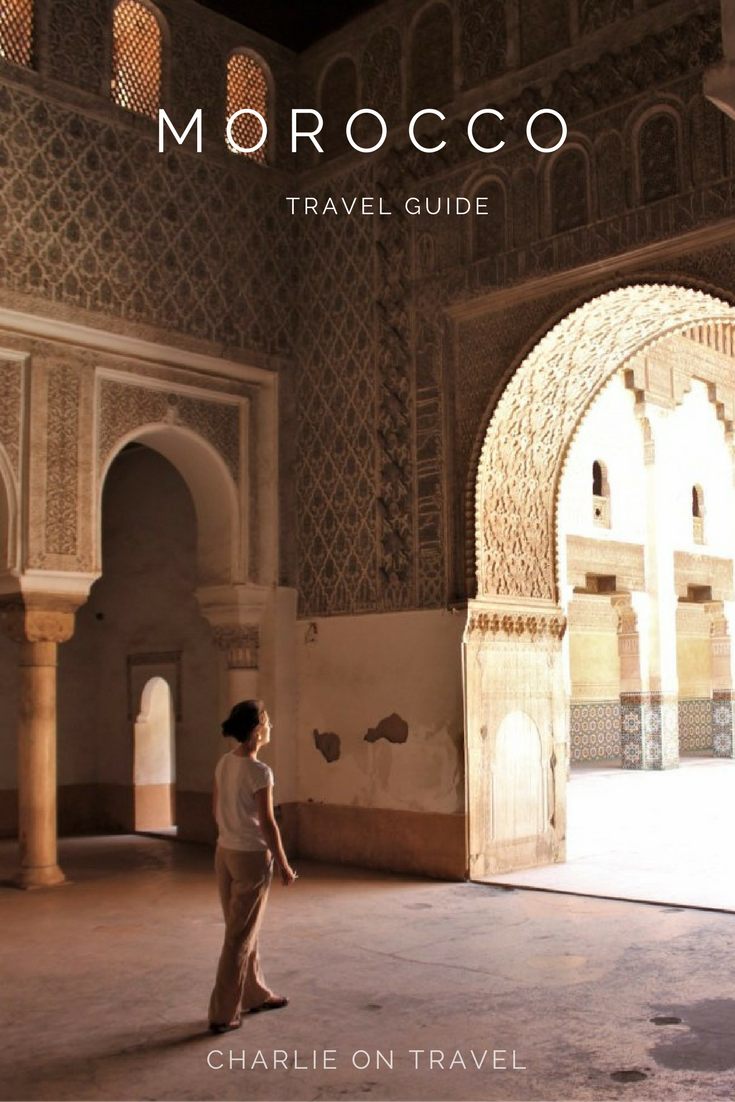
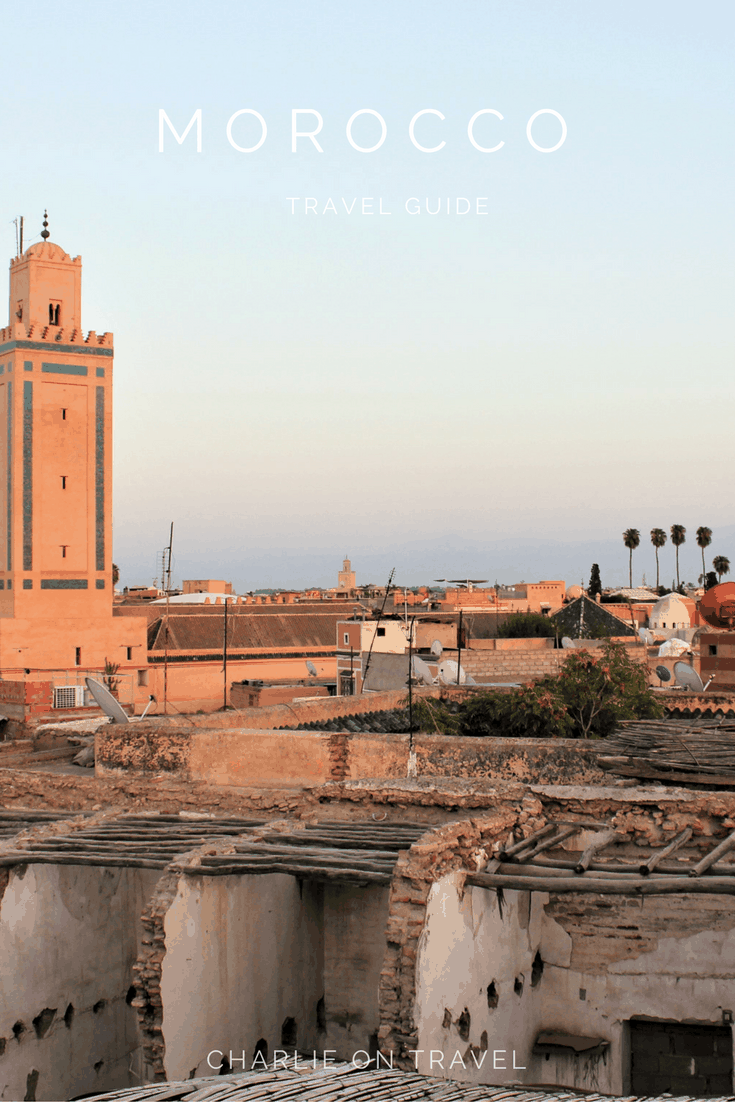





Martinez Ahtziri
This info is very helpful!!! Thanks for sharing!!!
Gioko Pat
Morocco looks awesome and you sure did not leave anything out in this write-up. For me, I would start with Marrakesh. I do love the din of an open air market.
Andrew Robson
Hey,
Great post with lots of useful info.
I’m flying into Marrakech 5th December and spending 10 nights in Morocco. I had been looking at something similar to your route but obviously taking into account, I have 10 days.
I will be spending my first 4 nights between Marrakech and Essaouria and then travelling a kind of loop taking in Ouarzazate, Imlil and perhaps onwards to the Southern Coast and back to Marrakech.
Not set in stone but kinda like that a bit, but will look into a couple of the places you mention for sure.
Niclas
Really great post guys. I just came home from my second trip to Morocco and absolutely loved it! It was such an incredible experiences. Regarding the desert I feel exactly the same way that you do. During my first trip I took a desert tour and didn’t enjoy it as much as hoped. However during my second visit I planned everything myself and did the Sahara trip without a tour, and really enjoyed! Morocco is just such a beautiful country :)
Colt Fetters
Beautiful images! Hannah (my fiancee) and I have been wanting to travel to Morrocco to do some elopement photography. This looks like a perfect spot! Your photos and words make us want to do that even more. Keep it up!
Charlie Marchant
Thanks for your comment, Colt. Hope you and Hannah make it out there and enjoy!